“We pay what we think is right for the person. No more, no less !”
This is what the HR manager had told me when I tried to negotiate my pay when accepting a full time role for which I was already overqualified. I realised then how unfair and biased the comment was. I still accepted the offer.
It took me a few more months to realise that what he meant was that I was not in his (and by extension the company’s) view the sole earner and so did not qualify for the pay grade my male colleagues were at. I stayed on in the job for two whole years, during which I tried to raise this disparity with management before leaving.
No, I did not sue the company. Not many people do.
The best thing about the HR manager’s matter-of-fact comment was the impetus it gave me to start my company and advocate for pay parity. Not just for deserving and qualified women but people from every minority group.
Since then, I have tried to bring it up with a lot of people to get them to speak up. Most women say that they know they are paid less and accept it as they value the job. Some women tell me the pay gap is one of the reasons they left leadership positions (it was just not enough to work twice as much and still earn less than their male counterparts). Most men though are simply incredulous. They don’t really believe that the pay gap exists.
It’s real everyone!
Here’s some data. The World Economic Forum (WEF) recently published data which says India is just 17 places away from being absolute lowest at paying women what they deserve. If this is not an eye opener I don’t know what is.

If you need some data to compare, the pay disparity in the US is 16% while the UK is at 14.3%. Although no country has yet achieved full gender parity, Iceland, predictably tops the chart with 8.2% disparity.
From Marie Curie making a mark in the field of Science to Malala Yousafzai advocating for Education Rights, women have shattered barriers worldwide. Yet in 2024, according to the World Economic Forum’s Global Gender Gap Index, women earn far less than men for the same work. This persistent gap not only hinders economic progress but also perpetuates systemic inequality.
Many people feel confused by the wide pay disparity. Especially when there is only a 5 to 10% wiggle room for salary difference between two people, how does pay gap increase? One reason: compounding. Over years, the increments add up
It’s everywhere
Most of the time when I bring it up I hear a defensive “But it’s everywhere”. It is. Let’s see some examples.
Cricket: Smriti Mandhana is India’s highest-paid female cricketer. BCCI announced equal match fees in 2022 and she earns the same as male cricketers for a day’s play as, say, Virat Kohli. However, Kohli’s annual contract offers 14 times what she gets. Mandana’s annual contract is $59K whereas Kohli’s is $840K.He also plays over double the international matches she turns out in.
Hollywood: A survey conducted by The New York Film Academy in 2014 found that the top ten male actors collectively made $419 million compared to the top ten female actors who made roughly $226 million collectively.
Tennis: Serena Williams was one of the leading campaigners when Wimbledon became the last grand slam to offer equal prize money in 2007. It took Wimbledon thirty-four years after the US Open decided to pay equally. Players such as Novak Djokovic and Rafael Nadal claimed men should earn more as they attract more people!
Yes we can do something about it
It’s very easy to give into accepting pay disparity. Most women I have interviewed do not negotiate. If you like a candidate, it’s easy to make the adjustment and pay what they ask for only once they negotiate. So you see, automatically women tend to fall into the lower end of the range you have earmarked for. It’s easy, as a manager: you are being judicious with the company’s resources.
But at Serein, we don’t.
Even for a small company we have policies which make sure men and women who are of the same caliber and same qualification, with the same level of expertise will get paid the same if they do the same job. It requires deliberate thinking, a lot (a LOT) of time invested during planning, and restructuring of the budget. But we make the effort. There have been times where I have had to nudge a candidate to have ‘that awkward’ conversation so they could openly ask about salary.
What can you do? If you are a manager – think twice while putting people into bands, deciding their increments and having the negotiation conversation.
If you are an individual, ask.
Change can happen. Even though Iceland (91.2%), Norway (87.9%) and Finland (86.3%)top the chart on pay parity, surprisingly countries such as Lithuania (81.1%) and Nicaragua (80.2%) make it to the top ten as well.
One interesting way to tackle this problem is by following the concept of Couple Equity as proposed by Nobel Laureate Claudia Goldin. She strongly believes that if women can achieve equity within their families, they can definitely achieve equity at work too!


